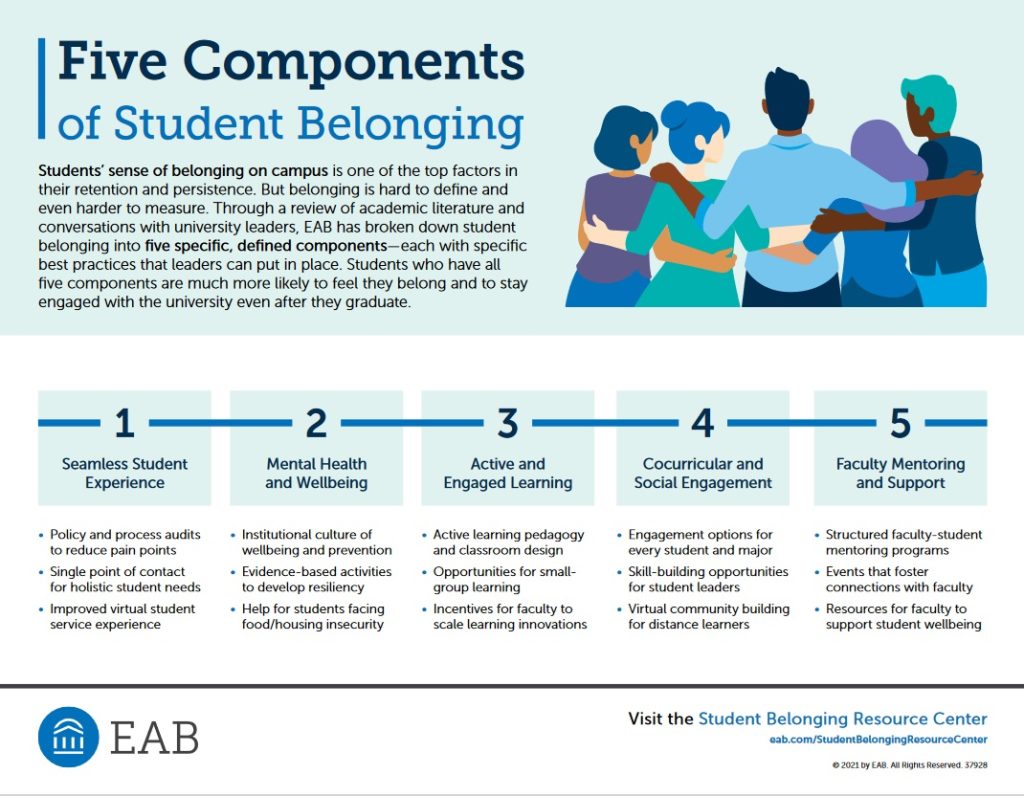 Viktor, Adobe Stock Images
Viktor, Adobe Stock Images A recent survey from the consulting firm EAB has found that university attempts to cultivate student “belonging” are having mixed success. However, most students are still satisfied with their educational choice. Consisting of responses from over 12,600 young adults, the survey found that 84 percent of first-year students were satisfied with their college experience to date. That is an increase from the 68 percent who said as much in 2020 but still below the 2019 mark of 87 percent.
It’s good to know that student satisfaction rates are continuing to improve from the 2020 dip. Perhaps the pandemic helped students better determine if college was the right path for them or if alternative degree pathways were a viable option.
Colleges can’t force students to connect and get involved, so, past creating opportunities, they can’t do much. To gain a better understanding of what factors have most influenced students’ increased satisfaction, EAB pressed further. They found that “a sense of belonging was highly correlated with overall levels of satisfaction.” The concept of belonging is not unique to the world of higher education. In fact, the field of psychology has found “a sense of belonging” to be a “universal and fundamental human motivation.” When considered in the context of college education, feelings of belonging can improve “academic outcomes, increas[e] continuing enrollment, and [protect] mental health,” all of which are excellent perks. Since students’ feelings of belonging are an important factor for retention and overall success, helping students integrate into their college community is of benefit to both institutions and students alike. It is not surprising that many institutions are working to ensure that this happens.
So how exactly would a school go about trying to improve student belonging? While admitting that defining and measuring a sense of belonging is quite difficult, EAB lays out five components:
1. Seamless Student Experience
2. Mental Health and Wellbeing
3. Active and Engaged Learning
4. Cocurricular and Social Engagement
5. Faculty Mentoring and Support

Upon reviewing these recommendations, one finds that schools really can work to make campus life better. For example, improving customer satisfaction by developing “single point[s] of contact for holistic student needs” is obviously a good move. A happy student is one who doesn’t have to traipse all over campus looking for an answer to his or her basic questions. Other recommendations on EAB’s list, however, illustrate a crucial weakness in “belonging” ideology. It is ultimately up to students themselves to ensure that they belong. Despite their best efforts, colleges can’t curate a sense of belonging for everyone. In the same way that parents can’t go out and make friends for their children (and aren’t expected to), institutions of higher education can’t force student connection and community, however well they offer “engagement options for every student and major.”
One wonders if the sheltering and infantilizing of today’s college students is actually to blame for feelings of exclusion. Similarly, while schools can encourage an “engaged” classroom and student body, it is each student’s choice to be an engaged learner; “opportunities for small-group learning” may be readily available, but not every student will choose to show up. Colleges can’t force students to connect and get involved, so, past creating opportunities, they can’t do much. As the saying goes, you can lead a horse to water, but you can’t make it drink.
Unsurprisingly given the political climate on today’s campuses, EAB found that “nearly one-third of students, 31%, felt targeted, criticized, or excluded based on their identity.” Furthermore, “while college campuses have faced criticism in recent years for creating excessively sheltering spaces for students, [EAB’s] data indicat[e] the real sense of exclusion that many students feel on campus.” One wonders, however, if the sheltering and infantilizing of today’s college students is actually to blame for these feelings of exclusion. If students enter higher education expecting colleges to take responsibility for their feelings, many will be disappointed. This is especially true if they are waiting around to be handed lifelong friendships and impactful conversations regarding their “identities” but aren’t willing to put in the work to achieve those relationships and experiences.
Ultimately, considering the fact that student belonging is of benefit to colleges, institutions should not stop trying to present students with opportunities to get involved. However, students should not expect to have their hands held throughout college. Colleges can only encourage belonging (and, as the Martin Center has written in the past, efforts to do so too hamfistedly often backfire). It is students themselves who must act upon the opportunities with which they are presented. Perhaps EAB can do a follow-up poll to see how many students take advantage of opportunities and actively engage with their peers in open, collaborative, and apolitical ways. That would likely prove to be an interesting read.
Ashlynn Warta is the state reporter for the James G. Martin Center for Academic Renewal.
